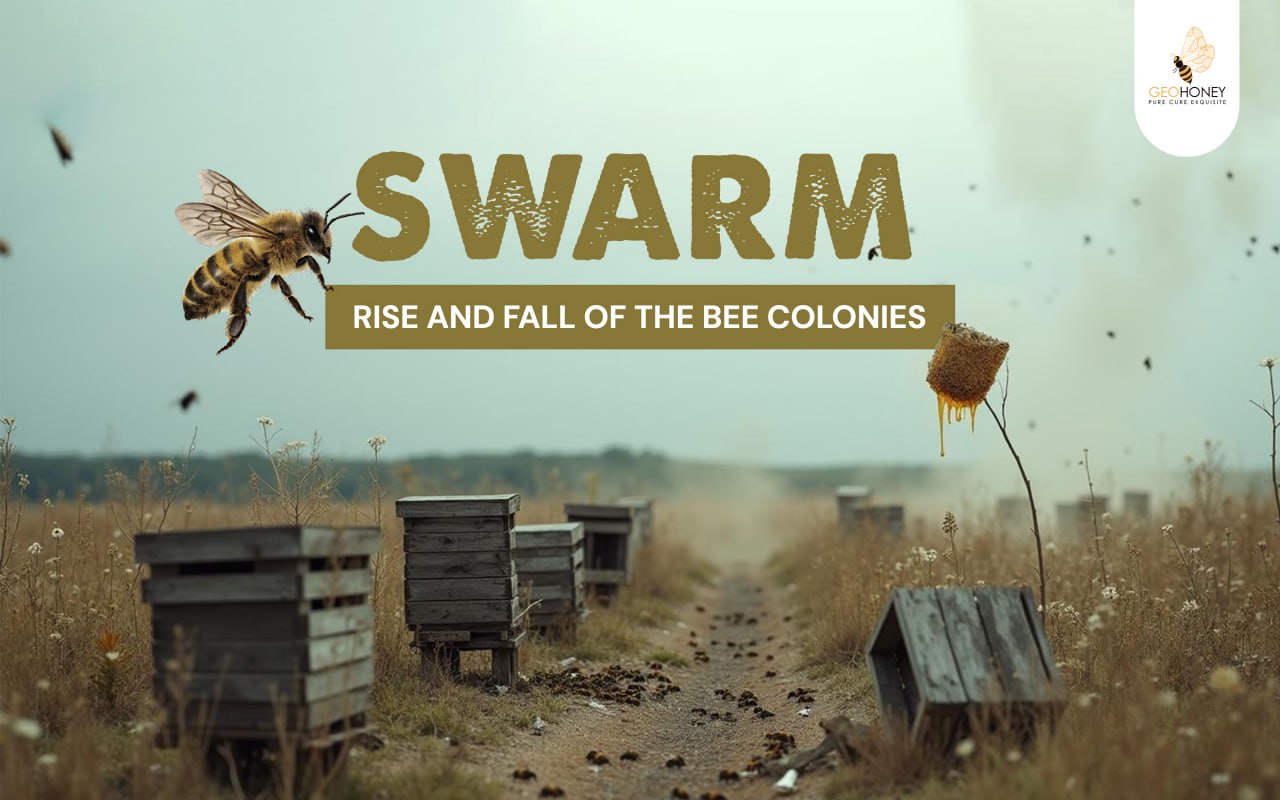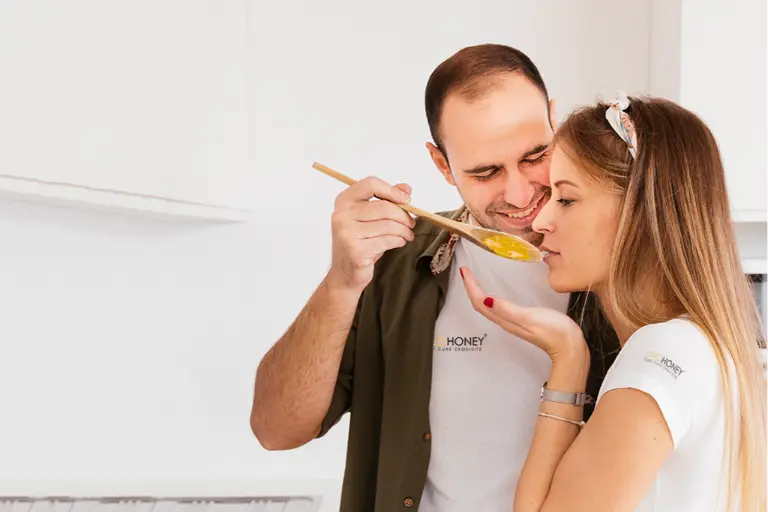- Tokyo: 11:40
- Singapore: 10:40
- Dubai: 06:40
- London: 02:40
- New York: 21:40
Swarm: Rise and Fall of the Bee Colonies

You might remember seeing a huge number of honey bees travelling around in a group at some point in your life. These bees are not out looking to sting you or to look for floral nectar to prepare honey. They are out there for a very specific reason, i.e., the search for their new home.
A honeybee swarm is a small honey bee colony that includes an old mated queen along with several hundred, if not thousands, of worker bees. But what is honey bee swarming, and why do bee colonies feel the need to do it?
“Swarming is absolutely essential for the survival of bee colonies as it ensures every bee gets enough resources and space to grow and do their part”, says the founder of Geohoney and the CEO of B A Barry Group, Mr Basem Barry.
This blog explores the swarming of honey bees in detail. This article covers the basics of honey bee swarming and its impact on bee colonies, so keep on reading till the end to learn more.
What is a Honey Bee Swarm?
Why Do Honey Bees Swarm?
When Do Bees Tend to Swarm?
Bee Swarming Process: The Rise and Fall of Honey Bee Colonies
Honey Bee Absconding
Honey Bee Supersedure
Is Bee Swarming Dangerous?
What is a Honey Bee Swarm?
Honey bees are very interesting creatures with a distinct set of behaviors you don’t normally observe in other flying insects. One key turning point in the lifecycle of a bee is being a part of a honey bee swarm.
Honey bee swarms, in simple terms, are groups of bees (about two-thirds of the total bees in a hive) and their old queen leaving their old hive to establish a newer colony, one where every bee can do its job freely.
Swarming is a natural process of bee colony reproduction that occurs when a bee colony outgrows its old home and the place becomes too congested or populated. In this case, worker bees build special wax cells to raise a new queen who will be in charge of the colony and assume the duty of laying eggs once the old queen moves out.
The swarm that leaves the colony chooses a nearby location (about 100 feet away from the old colony) to settle, which could be either a tree branch or the side of a building.
Then, scout bees are sent away to look for or build a new hive. Eventually, the swarm moves from this temporary abode to a newer, more spacious, well-protected, and sun-facing colony.
Why Do Honey Bees Swarm?
The entire honey bee colony works like a living organism. Honeybees give birth to honey bees, and in a similar manner the old colony produces a newer one. This is why swarming is often referred to as the reproduction of a honey bee colony.
Swarming begins when a honey bee colony becomes very crowded. This creates a scarcity of resources that bees need to thrive or produce pure organic honey. Eventually, the health of the entire colony begins to decline, making it essential for the bees to swarm.
In the warmer weather, bees rear a lot of broods to increase their worker population. This is done to prepare the hive for the upcoming foraging season. However, this rapid population growth causes the honey bees to outgrow their hives.
The rapid population growth also makes it nearly impossible for the queen bee’s pheromones to control the workforce. This affects the proper functioning of the hive negatively.
The pheromones released by the queen suppress new queen rearing, inhibit worker reproduction, and stimulate worker cohesion and other activities like cleaning, foraging, brooding, etc.
The absence of the queen’s pheromones disrupts all these processes. This urges the worker bees to signal for the swarm.
The increasing population inside the hive increases internal temperatures and humidity and reduces ventilation. As bees are very serious about what goes on inside the hives, it triggers the swarm.
Another less common factor is the weather that is prevalent around the hive. If the weather outside is very humid or warm, it can lead the bees to swarm to get away from this unpleasant living condition.
When Do Bees Tend to Swarm?
The honey bees usually swarm during the spring season between March and May. This is the time when blooming plants are plentiful, leading to countless nectar and pollen sources that bees can forage.
Before this period, bees spend an entire winter inside the hives reproducing and growing in number. As the weather becomes warmer, about half of the bees start considering swarming to make a new colony, which makes room for a newer queen to take charge of the older colony to better regulate the hive’s functions.
Bee Swarming Process: The Rise and Fall of Honey Bee Colonies
When the hive becomes too congested, it is time for the worker bees to signal the swarm. They start by building swarm cells inside the old hive for potential future queens.
A swarm cell is a special space that typically hangs from the bottom of the brood frames of the hives. If the swarm cell is in the middle of the frame, it usually means the bees are not swarming. Instead, they are simply replacing the sick or very old queen with a newer one.
Before leaving the hive, the old queen lays eggs in these special queen cups, which then hatch into larvae. These larvae are fed royal jelly by the worker bees until they grow enough to assume the role of a queen.
The virgin queens emerge from these cells and look for other swarm cells. They kill other developing queens until only one remains in the hive.
The old queen quits laying eggs which reduces her weight. This makes it easy for her to fly out of the hive with the worker bees. On the swarm day, usually between 10 AM to 2 PM, the worker bees move frantically. They chase the queen out of the hive until she is willing to comply. The honeybees leaving the hive stuff their bellies with nectar so that they have enough energy for the journey.
The queen then leaves with a massive cloud of bees, eventually resting on a tree branch. The queen then emits pheromones that signal the workers bees to cluster around her.
The cluster stays in this location while the scout bees look for their new home. In some cases, the entire cluster will leave one temporary location and move on to the next, about a mile or more away, until they find a new hive.
Once the scouts find a location, they will come back and perform a waggle dance to indicate the direction of the new hive.
Once a new hive is located, the entire cluster will move there and start developing comb, brood, etc., giving rise to a new colony where bees can store nectar and create raw honey.
In the old hive, the new queen emerges after 16 days of the swarm. This queen takes mating flights to find drones that she can mate with. This allows her to start the process of laying eggs and rebuilding the old hive’s population.
Honey Bee Absconding
Absconding is different from swarming. In swarming, about half or two-thirds of the worker bees, along with their queen, move out of the hive. But in absconding, the entire population of the colony leaves the hive.
There can be many reasons behind this tough decision. The absconding may happen due to a lack of food or water near the hive. It can also result from the presence of parasites, diseases, or external predator threats. Honey bees usually abscond around fall when the hive’s conditions become somewhat less habitable.
Honey Bee Supersedure
Another important process inside a beehive is supersedure. It is the process of replacing the hive’s queen with a newer one without any swarming. If the queen is very old, sick, or defective in some way, worker bees decide to replace her with a younger one. This is usually done after killing the previous queen, who is not able to perform her duties very well.
Is Bee Swarming Dangerous?
Honey bees in the process of swarming do not pose a great threat to humans. Bees only sting when they feel like their hive is in danger. But in this case, they are more interested in looking for a new place to rebuild the colony, which lowers their guard.
Moreover, before leaving, the bees consume a lot of nectar, as we mentioned before. This also reduces their activity, which leads to fewer dangers to humans.
However, it is still advised that you don’t mess around with their cluster as it can trigger their defensive response.
Conclusion
Swarming is the natural phenomenon wherein a significant portion of bees move out with their old queen in search of a new hive. This is usually the result of bees outgrowing their old hive. Swarming divides the bees from the original hives into two groups.
As one group leaves, the remaining bees rebuild the hive with their new queen. The bees that move out find a new hive where they can take care of their brood, reproduce, and store nectar or honey.
This way, swarming gives every bee of the colony a chance to start afresh in a hive that has more space and resources for everyone. This is what makes swarming very essential for the survival and growth of any bee colony that has more members than the hive can support.
Visit us at Geohoney to explore our premium quality raw honey products sourced from the best honey producers from all over the globe.




This is the process in which they re forming new colony, tend to leave the old hive. And once a site is chosen, the entire swarm flies off to start a new hive.